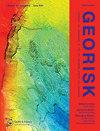“岩土工程中的机器学习与人工智能”特刊
IF 4.8
3区 工程技术
Q1 ENGINEERING, GEOLOGICAL
Georisk-Assessment and Management of Risk for Engineered Systems and Geohazards
Pub Date : 2023-01-02
DOI:10.1080/17499518.2023.2185938
引用次数: 1
摘要
机器学习和人工智能塑造岩土工程实践(可能还有理论)的潜力是巨大的。然而,岩土工程中机器学习的议程不应该只关注应用或开发算法。产生这些数据的岩土技术背景很重要。上下文可以与统计、物理或经验相关。统计学是指岩土工程数据的属性与经典统计学中的假设(大样本量、空间/时间/参数独立性、同质性、正态性等)有显著差异。Phoon, Ching和Shuku (2022a)认为岩土工程场地数据是“丑陋的”,因为它们在空间上是变化的、稀疏的、特定于场地的(或在某种程度上是唯一的),并且在多元数据库中充满了空条目,这意味着在某些位置/深度缺乏一些测量。不完整性属性源于在最小化现场调查预算的同时,最大化不同土壤参数和岩土/地质空间相关性之间相互关联的信息的意图。在这一点上,信息优化的价值是一门艺术,而不是一门科学。从MUSIC-3X(多元、不确定和唯一、稀疏、不完整和潜在损坏的“3X”表示3D空间变异性)数据中提取有用见解的科学挑战直到最近才被认为是棘手的(Phoon, Ching, and Shuku 2022a)。这些“丑陋”的数据属性在现场调查报告中是常态。在岩石工程中,数据可以是分类的,而不是数字的。Phoon(2023)强调:“每个学科的决策都有其独特属性的数据和成功实践(调查、设计、施工、测试、监测和风险管理方法)的传统支持,这些传统是为了充分利用这些数据和流行技术而发展起来的。”物理学指的是将“数字”与“意义”联系起来的一套理性知识。由物理学结果支持的决策是“可解释的”和“可解释的”。有限元法是岩土工程中最常用的物理方法。使用有限元分析,工程师可以理解因果关系(可解释性),并知道哪些输入参数会影响输出(可解释性)。工程师区分材料和状态参数,有效和总应力参数,以及物理或数值模型的输入和输出参数。当人们从物理学的角度来看待数据时,这些区别就存在了。经验是指从有意识的练习中积累的经验知识。它受到工程师在其工作生涯中遇到的项目范围的限制,并且无法与其他工程师有效地共享。与统计学和物理学相比,它主要是主观的和定性的。尽管如此,许多工程师认为经验至关重要。例如,辛普森(2011)解释了为什么欧洲规范7 (EC7)的表述是为了确保工程师在决策中始终拥有完全的所有权:“EC7试图通过让设计师负责材料特征值的选择来做到这一点,避免其推导的数学处方。在这个过程中,不可避免地会产生受设计师主观经验、知识和判断影响的价值观。笔者认为,与其抛弃这种主观性所提供的有价值的信息,还不如接受这种主观性。”在机器学习中,经验被视为一种“厚数据”,以区别于更广为人知的定量“大数据”。当前实践中的决策是基于物理和经验的。除了定性的指导方针,如伯兰三角(伯兰1987;Phoon et al. 2022b)或Wroth规则(Wroth 1984;Phoon 2023)。因此,岩土工程实践更多地被认为是一门“艺术”而不是一门“科学”。Phoon(2023)认为,鉴于数字技术的日益强大、无处不在和融合,决策将越来越多地依赖于数据,并提出了一个数据支持决策指数(DIDI)来跟踪这一演变。将岩土可靠度视为一个阶段本文章由计算机程序翻译,如有差异,请以英文原文为准。
Special issue on “Machine learning and AI in geotechnics”
The potential for machine learning and artificial intelligence to shape geotechnical engineering practice (and possibly theory) is immense. However, the agenda for machine learning in geotechnics should not be focused on applying or developing algorithms alone. The geotechnical context that gives rise to the data is important. The context can be related to statistics, physics, or experience. Statistics refer to the attributes of geotechnical data that depart significantly from the assumptions in classical statistics (large sample size, spatial/temporal/parametric independence, homogeneity, normality, etc.). Phoon, Ching, and Shuku (2022a) argued that geotechnical site data are “ugly”, because they are spatially varying, sparse, site-specific (or unique to some extent), and incomplete in the sense that a multivariate database is full of empty entries denoting lack of some measurements at certain locations/depths. The incompleteness attribute arises from an intent to maximize information on cross correlations between different soil parameters and geotechnical/geologic spatial correlations across a given site while minimizing the site investigation budget. At this point, this value of information optimization is an art rather than a science. The scientific challenge to draw useful insights from MUSIC-3X (Multivariate, Uncertain and Unique, Sparse, Incomplete, and potentially Corrupted with “3X” denoting 3D spatial variability) data was thought to be intractable until recently (Phoon, Ching, and Shuku 2022a). These “ugly” data attributes are the norm in a site investigation report. In rock engineering, data can be categorical rather than numerical. Phoon (2023) emphasized that “decision making in every discipline is supported by its own data with unique attributes and a tradition of successful practice (investigation, design, construction, testing, monitoring, and risk management methodology) that evolved to make the best use of these data and prevailing technologies”. Physics refers to a body of rational knowledge that associates a “number” to “meaning”. Decisions supported by physics-informed results are “explainable” and “interpretable”. The finite element method is the most prevalent embodiment of physics in geotechnical engineering. Using finite element analysis, an engineer understands cause and effect (interpretability) and knows which input parameters affect the outputs (explainability). An engineer distinguishes between material and state parameters, between effective and total stress parameters, and between input and output parameters from a physical or numerical model. These distinctions exist when one approaches data from the lens of physics. Experience refers to a body of empirical knowledge accrued from deliberate practice. It is restricted by the range of projects encountered by an engineer over his/ her working life and it cannot be shared with other engineers efficiently. In contrast to statistics and physics, it is mainly subjective and qualitative. Nonetheless, many engineers regard experience as critical. For example, Simpson (2011) explained why Eurocode 7 (EC7) is worded to ensure an engineer always take full ownership in decision making: “EC7 attempts to do this by making the designer responsible for the selection of the characteristic values of materials, avoiding mathematical prescription of their derivation. Inevitably, such a process leads to values affected by the subjective experience, knowledge and judgement of the designer. The author would contest that it is better to accept such subjectivity than to discard the valuable information it provides”. In machine learning, experience is regarded as one type of “thick data” to distinguish it from the more well-known quantitative “big data”. Decision making in current practice is based on physics and experience. There is no formal basis underpinning decision making other than qualitative guidelines such as Burland’s Triangle (Burland 1987; Phoon et al. 2022b) or Wroth rules (Wroth 1984; Phoon 2023). As such, geotechnical practice is regarded more of an “art” than a “science”. Phoon (2023) argued that decision making will be increasingly data-informed given the increasing power, ubiquity, and convergence of digital technologies and presented a data-informed decision support index (DIDI) to track this evolution. Geotechnical reliability is regarded as one stage with
求助全文
通过发布文献求助,成功后即可免费获取论文全文。
去求助
来源期刊
CiteScore
8.70
自引率
10.40%
发文量
31
期刊介绍:
Georisk covers many diversified but interlinked areas of active research and practice, such as geohazards (earthquakes, landslides, avalanches, rockfalls, tsunamis, etc.), safety of engineered systems (dams, buildings, offshore structures, lifelines, etc.), environmental risk, seismic risk, reliability-based design and code calibration, geostatistics, decision analyses, structural reliability, maintenance and life cycle performance, risk and vulnerability, hazard mapping, loss assessment (economic, social, environmental, etc.), GIS databases, remote sensing, and many other related disciplines. The underlying theme is that uncertainties associated with geomaterials (soils, rocks), geologic processes, and possible subsequent treatments, are usually large and complex and these uncertainties play an indispensable role in the risk assessment and management of engineered and natural systems. Significant theoretical and practical challenges remain on quantifying these uncertainties and developing defensible risk management methodologies that are acceptable to decision makers and stakeholders. Many opportunities to leverage on the rapid advancement in Bayesian analysis, machine learning, artificial intelligence, and other data-driven methods also exist, which can greatly enhance our decision-making abilities. The basic goal of this international peer-reviewed journal is to provide a multi-disciplinary scientific forum for cross fertilization of ideas between interested parties working on various aspects of georisk to advance the state-of-the-art and the state-of-the-practice.

 求助内容:
求助内容: 应助结果提醒方式:
应助结果提醒方式:


